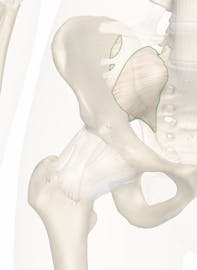The Anterior Sacroiliac Ligament
Explore Innerbody's 3D anatomical model of the anterior sacroiliac ligament, a key accessory to the sacroiliac joint.

The anterior sacroiliac ligament is one of the major accessory ligaments of the sacroiliac joint. It holds the sacrum and iliac bones together, reinforcing the sacroiliac joint. At the end of pregnancy, the hormone relaxin softens the connective tissue of the sacroiliac joint, increasing the flexibility of the hip joint for childbirth.
Anatomy
The anterior sacroiliac ligament is a thin, fan-shaped ligament found on the anterior side of the sacroiliac joint. It arises from the anterior surface of the ala of the sacrum and extends laterally to cross the sacroiliac joint. The fibers of the anterior sacroiliac ligament slightly diverge so that it widens as it crosses the joint, giving it a fan shape. Once it reaches the ilium, it terminates across a broad C-shaped band on the auricular surface of the ilium and along the preauricular sulcus.
Like all ligaments, the anterior sacroiliac ligament is made of dense regular fibrous connective tissue. It contains many strong collagen fibers arranged into parallel bundles, giving it enormous strength in the direction of the fibers. Fibroblast cells reside between the fibers, producing collagen proteins as the ligament grows throughout childhood and repairing broken fibers throughout a lifetime.
Physiology
The sacroiliac joint is a synovial planar joint that allows a slight gliding movement between the sacrum and the ilium. To withstand the stresses of supporting the body’s weight, several accessory ligaments reinforce its joint capsule, including the anterior sacroiliac ligament. The anterior sacroiliac ligament holds the sacrum and ilium together tightly on its anterior surface, preventing extraneous movement at the joint.
At the end of pregnancy, the hormone relaxin is secreted by the ovaries and placenta to soften the cartilage and ligaments of the pelvic joints, including the anterior sacroiliac ligament. The softened joint tissue increases the flexibility of the joints, allowing the pelvis to flex and accommodate the head of the fetus during childbirth. During the last few weeks of pregnancy, some pregnant people may notice gait changes or pain while walking due to the loosened joints.


